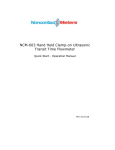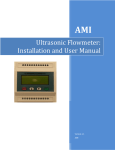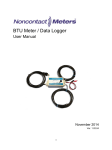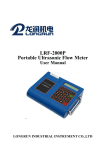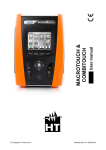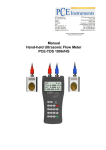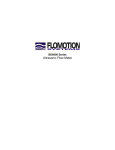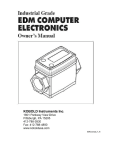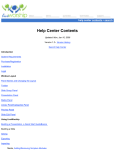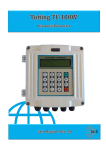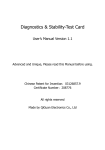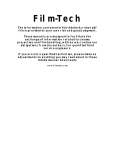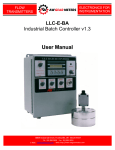Download ncm-603 hand held clamp-on ultrasonic transit
Transcript
NCM-603 HAND HELD CLAMP-ON ULTRASONIC TRANSIT TIME FLOWMETER - Quick Start - Operation Manual – Rev 8.27.08 This Quick Start is provided solely to help you get the flowmeter up and running as quickly as possible. Step 1. Power On Charge the battery fully before using the instrument. (The charging system is provide within your starter kit.) Press the ON button. The meter will go through a selfchecking process to make sure all is within normal working conditions. After a second, the screen similar to the figure on the right will appear. If it does not, please write down the error message and contact us. Step 2. Configure the Measurement Settings 2.1. Enter transducer info (skip this if you have only one transducer pair) Change the Scale Factor: Press keys M45 (e.g., press MENU, 4 and 5 keys orderly.) Then, press the ENT key. Key in the new scale factor of the transducer. 2.2. Enter pipe info M11 Pipe OD: press keys M11 (e.g., press MENU, 1 and 1 keys orderly), and then ENT. The display should be similar to the figure on the right. Now enter the pipe outer diameter, and press the ENT key to confirm. ENT and enter the pipe wall-thickness value. Press ENT again to confirm. M11 Outer Diameter 4.500 in =>_ M12 Wall-Thickness: Press to scroll down to the next menu M12. Press ENT and enter the pipe wall-thickness value. Press ENT to conform. M13 Pipe ID: Press to scroll down to the next menu, M13. The correct ID value should be displayed on the screen. M14 Pipe Material: Press to scroll down to M14. Press ENT & then use to select the right item. (Skip to pipe lining). If pipe material is not shown on the list (non-standard material), select any one of them. Press ENT to confirm. M14 Pipe Material =>0. Carbon Steel 1. Stainless Steel M15 Sound Speed in Pipe Wall: Press to scroll down to M15. If you find your pipe material on the list in the previous step, the flowmeter should already know the sound speed. You can just skip this step and go to the next. Otherwise, press ENT and enter the sound speed of your pipe material. You can find this information in the User’s Manual. When you are done, press ENT to confirm. M16 Pipe lining: Press for next: If your pipe has lining inside, enter the lining information on menu windows M16-M18. 3 2.3. Enter fluid info M20 Fluid Type: Use the key to scroll down to M20, or, simply press keys M20. Then, press ENT and select the item that matches your fluid type. If you do not find a match (non-standard fluid), choose #8 (other). Press the ENT key to confirm. Sound Speed in Fluid: If you found your fluid type in the previous step, the flow meter already has the sound speed info. Therefore, skip this step and go the next. Otherwise, press to scroll down to M21. Press ENT and key in the sound speed of your fluid. You can find this information in the User’s Manual. When you are done, press ENT to confirm. 2.4. Enter transducer installation info M23 Mounting Method: Use the key to scroll down to M24 or press M24. Then Press ENT and select the proper item and press ENT to confirm. For pipes < 1” try W-method. For pipes from 2” to 12” use the V method. For pipe sizes > 12 inches use the Z method. Step 3. Install M24 Txducer Mounting =>0. V-Method 1.0 Z-Method Transducers M25 Mounting Spacing: Use the key to scroll down to displayed value is the mounting spacing between the two transducers (see the figure on the right). Write down this number, as you will need it later when installing the transducers. M25 M25. The Txducer Spacing 3.80 in =>_ M26 Saving Parameters: Now that you have enter all the values needed. We should save the changes. Choose anyone of the 17 memory location you want to save it to. (This is for backup purposes.) -3- Step 4. Fine Tuning On the main unit, press M90 to enter into menu M90. There are three important numbers displayed on this window (refer to the figure below): Transit-time ratio R (it is the % value on the upper right), signal strength S and signal quality Q. Their values shall fall into the right ranges in order t o justify the reading: R: 97% ~ 103% S: 600 ~ 990 Q: 60 ~ 99. M90 100.39% Strength+Quality S=819,822 Q=88 System Normal If these values are not in the above ranges, you need to verify the parameters you have entered in Step 2. If you believe your entries are correct and the three numbers are still off their ranges, you may need to check your installation. Here are some tips: Moving transducers closer to or away from each other will increase or decrease the transit-time ratio R. The sound speed information in menu M92 might also be useful for debugging. The displayed value should be close to the one you have entered in step 2.3 (M15). If you have entered fluid type in step 2.3 instead, and you do not know the fluid sound speed, you can find this information in the Appendix. M92 Fluid Sound Vel 0.0000 f/s If all the three parameters are good, your installation is done. You are ready to look at your measurement results on menu window M00. You should see an “R” in the low right corner of the main screen (M01~M05). This “R” indicates normal running Conditions. 4 Appendix Transducer Installation Guide A.1. Find the mounting site (A) Pipe must be full of liquids at the measurement site. (B) No heavy corrosion of deposition inside of the pipe. (C) Must be a safe location. (D) The straight run of the pipe must not be shorter than 15D as a general guideline, where D is the pipe diameter. Insufficient straight pipe length will degrade the accuracy of the results. (E) The transducer mounting site should be 10D straight run upstream and 5D straight run downstream (see the following drawing.) (F) If there are flow disturbing parts such as pumps, valves, etc. on the upstream, the straight pipe length should be increased. The disturbance strength of those flow conducting parts will be (low to high): Single Bend -> Pipe Reduction / Enlargement -> Outflow Tee -> Same Plane Multiple Bends -> Inflow Tee -> Out of Plane Multiple Bends -> Valve -> Pump A.2. Prepare the Pipe Surface Clean the pipe surface where the transducers will be mounted. Remove moisture, rust, and dirt. Wire brush the surface if not smooth. Dry up the surface. A dry, clean surface will ensure a good acoustic bond between transducer and pipe. A.3. Prepare the Transducer Clean the transducer surface. Keep the surface dry. Put lubricant grease on transducer surface as shown in the right figure. Do not put more than necessary, especially for small pipe. 5 A.4. Install the Transducers Notice: For horizontal pipe line, it is recommended to install the transducers on the side instead of on the top or bottom of the pipe. This is to avoid air bubbles on the top and sediments on the bottom of the pipe. A.4.3. M1 type transducer: First, mark the transducer installation location on the pipe surface according to the mounting spacing given in menu M25. You may need to make a paper template to help you accurately locate the transducer position, especially if you plan to use Z-method for the installation. Then, connect the mounting fixture around the pipe. Leave the chain loose so you can slip the transducer underneath. Apply a small amount of couplant in the prepared area of the pipe where transducers will be in contact. Slip the transducer under the clamp fixture. Tighten the screw. Do the same thing for the other transducer. Use the above figure as a reference. If the pipe material is metal, you do not need the clamp fixture. The transducers will automatically attach to the pipe by magnetic force. Finally, connect the Transducer cables to the main unit. Sales – Service – Support Contact Instruments Direct 501 Hickory Ridge Trail, Suite 110 Woodstock GA 30188 p888.722.5543 p678.445.7675 fx678.445.9993 [email protected] www.instrumentsdirect.com -6- NCM-603 MENU WINDOW DETAILS Briefs Description of Menu Windows The special feature of NCM-603 flow meter is the operation in windows. These windows are assigned as follows: Menu Brief Description of pages Flow Totalizer Display: to display flow rate, positive total, negative total, net total, velocity, M00~09 date & time, analog inputs for present flow, present operation and flow results today, etc. Initial Parameter Setup: for enter pipe outside diameter, pipe wall thickness, fluid type, M10~29 transducer type, transducer mounting and spacing, etc. Flow Units Options: to select the flow unit, totalizer unit, measurement unit, turn totalizers M30~38 on/off and reset totalizes, etc. M40~49 Setup options: Scaling factor, network IDN (Window No.46), system lock (Window No.47) Input and output setup: relay output setup, 4-20mA outputs, flow batch controller, LCD M50~89 backlit option, date and time, low/high output frequency, alarm output, date totalizer, etc. Diagnoses: Signal strength and signal quality (Window No.90), TOM/TOS*100 (Window M90~94 No.91), flow sound velocity (Window No.92), total time and delta time (Window No.93), Reynolds number and factor (Window No.94), etc. Appendix: power on/off time, total working hours, on/off times and a single-accuracy M+0~+8 function calculator. Complete Brake down of all pages: Menu No. Function M00 Display three positive negative net totalizers, signal strength, signal quality and working status M01 Display POS totalizer, flow rate, velocity, signal strength, signal quality and working status M02 Display NEG totalizer, flow rate, velocity, signal strength, signal quality and working status M03 Display NET totalizer, flow rate, velocity, signal strength, signal quality and working status M04 Display date and time, flow rate, signal strength, signal quality and working status M05 Display date and time, velocity, signal strength, signal quality and working status M06 Display the wave shape of the receiving signal M07 Display the battery terminal voltage and its estimated lasting time M08 Display the all the detailed working status, signal strength, signal quality M09 Display today's total flow, velocity, signal strength, signal quality and working status M10 Window for entering the outer perimeter of the pipe M11 M12 M13 Window for entering the outer diameter of the pipe 0 to 6000mm is the allowed ranged of the value . Window for entering the pipe wall thickness Window for entering the inner diameter of the pipe M14 Window for selecting pipe material. Standard pipe materials (that the user need not know the speed ) include:(0) carbon steel (1) stainless steel (2) cast iron (3) ductile iron (4) copper (5) PVC (6) aluminum (7) asbestos (8) fiberglass M15 Window for entering the pipe material speed only for non-standard pipe materials M16 Window for selecting the liner material, select none for pipes without any liner Standard liner materials that the user need not know the speed include: (1) Tar Epoxy (2) Rubber (3) Mortar (4) Polypropylene (5) Polystryol (6) Polystyrene (7) Polyester (8) Polyethylene (9) Ebonite (10) Teflon M17 Window for entering the liner material speed only for non-standard liner materials M18 Window for entering the liner thickness, if there is a liner M19 Window for entering the ABS thickness of the inside wall of the pipe. M20 Window for selecting fluid type for standard liquids that the user need not know the liquid speed include: (0) Water (1) Sea Water (2) Kerosene (3) Gasoline (4) Fuel Oil (5) Crude Oil (6) Propane at -45C (7) Butane at 0C (8) Other Liquids (9) Diesel Oil (10) Caster Oil (11) Peanut Oil (12) # 90 Gasoline (13) # 93 Gasoline (14) Alcohol (15) Hot water at 125C M21 Window for entering the fluid sonic velocity only for non-standard liquids M22 Window for entering the viscosity of the non-standard liquids M23 Window for selecting the proper transducers. There are 14 different types of transducers for selection. If the user-type-transducers are used, 4 user type wedge parameters, which will be prompted by the software, should be entered following. If the π type transducers are used, 3 π, type transducers and pipe parameters should be entered following. M24 Window for selecting the transducer mounting methods. Four methods can be selected: (0) V-method (1) Z-method (2) N-method (3) W-method M25 Display the transducer mounting spacing M26 Entry to store the parameter configuration into the internal NVRAM M27 Entry to load one set of saved parameters M28 Select YES or NO for the instrument to determine whether or not to hold (or to keep) the last correct value when poor signal condition occurs. Yes is the default setup. M29 Enter a value ranging from 000 to 999. 0 is the default value for empty pipe setup. M30 Window for selecting unit system. Default value is "Metric". The change from English to Metric of vice versa will not affect the unit for totalizers. M31 Window for selecting flow rate that will be used by the instrument afterward Flow rate can be in: 0. Cubic Meter short for (m3) 1. Liter (1) 2. USZ gallon (gal) 3. Imperial Gallon (igl) 4. Million USA gallon (mgl) 5. Cubic feet (cf) 6. USA liquid barrel (bal) 7. Imperial liquid barrel (ib) 8. Oil barrel (0b) The flow unit in terms of time can be per day, per hour, per minute or per second. So there are 36 different flow rate units in total for selection. M32 Window for selecting the totalizers"' working unit M33 Select totalizer multiplier. The multiplier ranges from 0.001 to 10000. M34 Turn on or turn off the NET totalizer M35 Turn on or turn off the POS totalizer M36 Turn on or turn off the NEG totalizer M37 (1) Totalizer Reset or (2) Restore the instrument to the default parameters as the manufacturer did by pressing the dot key followed by the backspace key. Tale care or make note on the parameters before doing the restoration M38 Press-a-key-to-run or to stop totalizer for easier calibration M39 Operational interface language selection in Chinese and English. M40 Flow rate damper for a stable valve. The input range is 0 to 999 seconds. 0 means there is no damping. Default value is 10 seconds. M41 Lower flow rate cut-off to avoid invalid accumulation. M42 Zero point setup under the condition when there is no liquid running inside the pipe M43 Clear the zero point by the user, and restore the zero point set by the manufacturer. M44 Set up a manual; flow bias. Generally this valve should be 0. M45 Scale factor for the instrument. The default value in "1". Keep this value as "1", when no user calibration has been made. M46 Network environmental Identification Number. Any integer can be entered except 13(0Dh), carriage return), 10 (0Ah, line feeding), 42 (2Ah), 38 (26h), 65535 (FFFFh). Every set of the instrument in a network environment should have a unique IDN. M47 System locker to avoid modification of parameters M48 Not used M49 Communication Tester M50 "Option" selection for the built-in logger. It also functions as the switch of logger M51 Time setup for the data logger M52 (1) Data logging direction control. If ' To RS-232 ' is selected, all the data produced by the data logger will be transmitted out through the RS-232 interface. (2) If ' To buffer ' is selected, the data will be stored into the built-in logger memory. (3) Buffer transferring and buffer clearing M53 Logger buffer viewer. It functions as a file editor. Use Dot, backspace UP and DN keys to browse the buffer. If the logger is ON, the viewer will automatically refresh once new data are stored M54 M55 M56 Not used Not used Not used M57 M58 M59 Not used Not used Not used M60 99-year calendar. Press ENT for modification. Use the dot key to skip the digits that need no adjusting. M61 Display Version information and Electronic Serial Number (ESN) that are unique for each TDS-100 series flow meter. The users can employ the ESN for instrumentation management. M62 RS-232 setup. Baud rate can be 75 to 115200 bps M63 M64 M65 M66 Not used Not used Not used Not used M67 Input the frequency range for the frequency output. The biggest range is 0HZ-9999Hz. Default value is 1-1001 Hz M68 Enter a flow rate valve that corresponds to lower frequency M69 Enter a flow rate valve that corresponds to higher frequency M70 LCD display backlight control. The entered valve indicates how many seconds the backlight will be on with every key pressing. M71 LCD contrast control. The LCD will become darker when a small value is entered. M72 Working timer. It can be cleared by pressing ENT key, and the select YES. M73 Enter Lower Flow Rate value that will trigger the # 1 Alarm. There are two virtual alarms in the system. By "virtual" we mean that the user must redirect the output of the alarms by seting up the output hardware in M78 and M77. M74 Enter the higher flow rate value that will trigger the # 1 Alarm M75 Enter the lower flow rate value that will trigger the # 2 Alarm M76 Enter the higher flow rate value that will trigger the # 2 Alarm M77 Buzzer setup. If a proper input source is selected, the buzzer will beep when the trigger event occurs. M78 OCT (Open Collect Transistor Output) setup By selecting a proper input source, the OCT hardware will close when the trigger event occurs M79 Not used M80 Work as a keypad and display for another bandhold set by RS-232 connected with the handset. M81 Not used M82 M83 M84 M85 M86 M87 M88 M89 Date totalizer Not used Not used Not used Not used Not used Not used Not used M90 Display signal strength, signal quality, time ratio on the upper right corner. M91 Displays the Time Ratio between the Measured Total Transit Time and the Calculated time. It the pipe parameters are entered correctly and the transducers are properly installed, the ration valve should be in the range of 100+ 3%. Otherwise the entered parameters and the transducer installation should be checked. M92 Displays the estimated fluid sound velocity. If this value has an obvious difference with the actual fluid sound speed, pipe parameters entered and the transducer installation should be checked again. M93 Displays total transit time and delta time (transit time difference) M94 Displays the Reynolds number and the pipe factor used by the flow rate program M95 M96 Not used Not used M97 Command to record the pipe parameters entered by the user either to the built-in data logger or to RS-232C serial interface. M98 Command to record the pipe parameters entered by the user either to the built-in data logger or to RS-232C serial interface. M99 Command to copy the current display either to the built-in data logger or to RS-232C serial interface. M+0 Browse the 64 recorded instrument power-on and power-off data and time with the flow rate at the time of power on and off M+1 Displays the total working time of the instrument M+2 Displays the last power-off date and time M+3 Displays the last power-off flow rate M+4 Displays the times of instrument powered on (the instrument has been powered on) M+5 A scientific calculator for the convenience of field working. All the values are in single accuracy. The drawback is that the user can't operate it by direct key-pressing Basic Troubleshooting: Menu 08 Codes: Press the MENU 0 8 keys. If the letter “*R” displays on the screen, it indicates system normal. If the letter “E” is read, it indicates that the current loop output is over ranged by 120%. This refers to the settings in Window No.57. Enter a larger value in Window No.57, and the letter “E” will disappear. It can be ignored if no current loop output is used. If the letter “Q” is read, it indicates that the frequency output is over ranged by 120%, and this refers to the settings in Window No.69. Increase the input value in Window No.69, and the letter “Q” will disappear. It can be ignored if no frequency output is used. If the letter “H” is read, it indicates that the ultrasonic signal detected is poor. If the letter “G” is read, it indicates that system is adjusting the signal gain prior to the measurement. Also, it means system normal. Only when the adjustment takes too long without stopping, can system be identified as abnormal. Letter “I” indicates no signal is being detected. Check the transducer wiring connections are correct, the transducers are installed firmly, etc. Letter “J” indicates a hardware defect exists. Normally, such defect is temporary; it could be eliminated by system reboot (power off and restart). ERROR Quick DIAGNOSES Section: The NCM-603 ultrasonic flow meter has adopted few errors, but sometimes problems may occur due to minor user error on the operation, wrong setting or terrible working environment. Therefore, it has an advanced self-diagnosis function to display the errors (M08). Hardware error diagnoses are normally performed upon each power on. Some errors can be detected during normal operation. Undetectable errors caused by incorrect settings and unsuitable measurement conditions can occur after the boot up. M08 helps to detect the errors and determine causes during good times; thus, problems can be solved in a timely manner according to the solutions listed in following tables. Errors displayed in the NCM-603 are divided into two categories: Table 1 is for circuit hardware errors displayed during self-diagnosis upon boot up. Table 2 applies when errors are detected during operations. A “F” may be displayed on the lower right corner of the screen after entering the measuring mode. When this occurs, it is necessary to restart the flow meter so the selfdiagnosis can once again try to detect and solve possible errors. If the error continues try to use the following tables to resolve the issue. If unable to resolve the error, please contact the manufacturer for assistance. The problems and solutions are given in the following tables. Table 1. Self-diagnosis and error solutions (during initial boot up) LCD Display Cause Memory Checking Error * System ROM illegal or error Stored Data Error * System ROM has an error * Contact the manufacturer * Memory parameter data Error * System stored data block error * Sub-CPU circuit fatal Error * System clock error * Press ENT key, and restore parameters to default System Data Memory Error Circuit Hardware Error Timer Slow Error Timer Fast Error Clock Error CPU or IRQ Error * Abnormal clock inside the Hardware * The CPU has developed Error Solution * Reboot then if error prosiest manufacturer * Reboot then if error prosiest manufacturer * Reboot then if error prosiest manufacturer Check the cell and contact the contact the contact the contact the manufacturer. * Reboot then if error prosiest contact the manufacturer Resetting Repeatedly Time or Date Error No Display, Erratic or Abnormal Operation Stroke Key - No Response * Could be a number of issues * System date time chip Error * Bad wiring connection or physical damage * Contact the manufacturer * Keypad locked * Keypad has a bad connection * Enter the unlock password if the keypad is locked. The state does not affect normal measurement if error prosiest contact the manufacturer. * Reset the dates and time. * Check wiring connections to see whether cable is ok. The state does not affect normal measurement. Table 2. Error codes and solutions (during operation) Code M08 Display Cause Solution *R System Normal * System normal If it isn’t broken, don’t fix it! *J Circuit Hardware Error Signal Not Detected * Hardware is defective Contact the manufacturer *Signal not detected. *Spacing is not correct between the transducers or not enough coupling compound applied to face of transducers. * Transducers installed improperly. * Scale is too thick. * Pipe liner is data is missing. * Low signal strength. * Cause refers to previous mentioned reasons. * Poor signal quality * All reasons are included in the abovementioned causes. * 4-20mA current loop over 100%. * Improper settings to current loop output. * Attach transducer to the pipe and tighten it securely. Apply a plenty of coupling compound. * Remove any rust, scale, or loose paint from the pipe surface. Clean it well. * Check the initial parameter settings. * Remove the scale or change the scaled pipe section. Normally, it is possible to change a measurement location. The instrument may run properly at a new site with less scale. * Input correct liner in the flow meter. *I *H Low Signal Strength *H Poor Signal Quality *E Current Loop over 20mA (Note: influence normally. Ignore it if no current output is being used.) Frequency output over set value (Note: influence normally. Ignore it if no frequency output is being used. ) Refer to Table 1. *Q *F *G Adjusting Gain>S1 Adjusting Gain>S2 Adjusting Gain>S3 Adjusting Gain>S4 (Display in M00, M01, M02, M03) *K Pipe Empty. Set in M29 to no fluid. * Solution refers to previous mentioned solutions. * Solution refers to above-mentioned solutions. * Check settings (refer to M56) and confirm if actual flow is too high. * Frequency output over 120%. * Improper settings to frequency output or actual flow are too high. * Check settings (refer to Window M66- M69) and confirm if the actual flow is too high. * Error in self-diagnosis during power on. * Permanent hardware error. *The four steps mean it is adjusting gain for normal measurement. *Stop in S1 or S2 and only switch between S1 and S2 indicates a poor waveform or low signal strength. No fluids are in the pipes, or the settings are not correct for current application. * Reboot; resolve it by the method listed in Table 1, if error prosiest contact the manufacturer. * Re-install transducers. * Try different mounting technique using M24 (don’t forget to remount the transducers’ accordingly if currently on ‘Z’ try ‘V’. if on ‘V’ try then ‘N’…) Once fluid is detected in the pipe, set 0 in M29. Frequently ask Troubleshooting Questions: Q: New pipe, high quality material, and all installation requirements are being met then “Why is there still no signal being detected?” A: Check pipe parameter settings, installation method and wiring connections. Confirm if the coupling compound is applied adequately, the pipe is full of liquid, transducer spacing agrees with the screen readings and the transducers are installed in right direction. Q: Why is the flow rate still displayed as zero while there is fluid obviously inside the pipe and a symbol of “R” displayed on the screen? A: Check to see if “Set Zero” was carried out with fluid flowing inside the pipe (Refer to M42). If it is confirmed, recover the factory default in M43. Q: Old pipe with heavy scale inside, no signal or poor signal detected: how can it be resolved? A: • 1 Check if the pipe is full of fluid. (If the pipe is not full or contain air bubbles, the NCM-602 will not able to function properly.) • 2 Try the Z method for transducer installation. • 3 Carefully select good pipe section and fully clean it, apply a wide band of coupling compound on each transducer face (bottom) and re-install the transducers. • 4 Slowly and slightly move each transducer with respect to each other around the installation point until the maximum signal is detected. Be careful that the new installation location is free of scale inside the pipe and that the pipe is concentric (not distorted) so that the sound waves do not bounce outside of the proposed area. • 5 For pipe with thick scale inside or outside, clean the surface well removal all obstructions/grinned, if it is accessible from the inside. (Note: Sometimes this method might not work and sound wave transmission is not possible because of the layer of scale between the transducers and pipe inner wall.)














